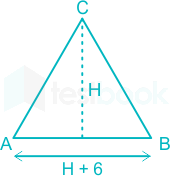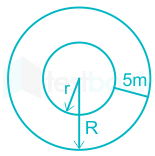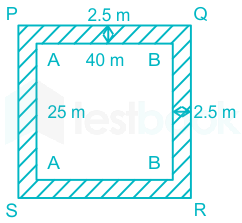- 10 √2 cm
- 40 cm
- 200 cm
- 40 √2 cm
The diagonal of the square is 20 cm.
Concept used:
Perimter = 2√2 x diagonal
Calculation:
⇒ Perimeter = 2√2 x 20 = 40√2 cm
∴ The diagonal of square is 20 cm, then perimeter of the square must be 40 √2 cm.
- 963 m2
- 639 m2
- 936 m2
- 693 m2
Area of the rectangle = length × breadth
Length of the field = 90 m
Breath of the field = 60 m
⇒ Area of the field = 90 × 60 = 5400 m2
Length of the field including path = 90 + 6 = 96 m
Breadth of the field including path = 60 + 6 = 66 m
⇒ Area of the field including path = 96 × 66 = 6336 m2
∴ Area of the path = 6336 – 5400 = 936 m2
- 42
- 36
- 45
- 33
A wire is in the shape of a square of side 66 cm
Formula Used:
The perimeter of a Square = 4 × Side
The perimeter of a Circle = 2πr
Calculation:
According to the question,
Perimeter of Square = Perimeter of Circle
⇒ 4 × 66 = 2 × (22/7) × r
⇒ 2 × 3 = r/7
⇒ r = 42 cm
∴ The radius of the circle is 42 cm.
- 7√6
- 6√11
- 5√8
- 8√2
The sides of a scalene triangle a = 8 cm, b = 5 cm, c = 9 cm
Formula used:
Using heron’s formula = √s × (s – a) × (s – b) × (s – c)
Where, S = semi – perimeter and a, b & c are the sides of the triangle
S = (a + b + c)/2
Calculation:
Here semi – perimeter (s) = (8 + 5 + 9)/2 = 11 cm
Using heron’s formula,
Area of the triangle = √s × (s – a) × (s – b) × (s – c)
⇒ √11 × (11 – 8) × (11 – 5) × (11 – 9)
⇒ √11 × 3 × 6 × 2
⇒ √396
⇒ 6√11 cm
∴ The correct answer is 6√11 cm.
- 12 cm.
- 13 cm.
- 14 cm.
- 15 cm.
If the side of the square is increased by 5 cm, the area increased by 165 sq.cm.
Formula Used:
Area of square = Side2
Calculation:
Let each side of the square be x.
⇒ (x+5)2 – x2 = 165
⇒ x2 + 25 +10x – x2 = 165
⇒ 10x +25 = 165
⇒ 10x = 140
⇒ x = 14.
∴ The side of the square is 14 cm.
- 1 : 4
- 4 : 1
- 2 : 1
- 1 : 2
⇒ Base of triangle = b/2
Let the height of parallelogram be h1 and height of triangle be h2
Given that the area of parallelogram is equal to area of triangle
⇒ 1/2 × b/2 × h2 = b × h1
∴ h2 ∶ h1 = 4 ∶ 1- 35 cm
- 30 cm
- 55 cm
- 33.5 cm
The sides of a triangle are in the ratio 4 : 9 : 7
The sum of the shortest and the longest sides is 65 cm.
Calculation:
Shortest side of the triangle = 4 units
Longest side of the triangle = 9 units
The sum of the shortest and the longest sides = 4 + 9
⇒ 13 units
According to the question,
13 units = 65 cm
So, 1 unit = 5 cm
Length of the third side = 7 × 5
⇒ 35 cm
∴ The required answer is 35 cm.
- 12 cm
- 9 cm
- 18 cm
- 27 cm
The length of the base of a triangle is 6 cm more than the corresponding altitude.
Area of the triangle = 108 cm2
Concept used:
Area of a triangle = 1/2 × b × h
b = base
h = height or altitude

Calculation:
Let the altitude be H cm
So, base = (H + 6) cm
According to the question,
1/2 × H × (H + 6) = 108
⇒ H2 + 6H – 216 = 0
⇒ H2 + 18H – 12H – 216 = 0
⇒ H(H + 18) – 12(H + 18) = 0
⇒ (H + 18)(H – 12) = 0
H = – 18, 12
Length cannot be negative so H = 12
So, base = 12 + 6 = 18 cm
∴ The length of the base of the triangle is 18 cm
- 25 m
- 20 m
- 30 m
- 24 m
Area of a triangle = 250 m2
Base : Height = 4 : 5
Formula used:
Area of a triangle = (1/2) × base × height
Calculation:
Let the base be 4x
Then height = 5x
Area of a triangle = 250 m2
⇒ (1/2) × 4x × 5x = 250
⇒ 10x2 = 250
⇒ x = 5
Height = 5x = 25 m
10. A rectangular filed had length 32 cm and breadth 20 cm. How many square tiles of 4 cm should be used to cover the rectangular field?
- 40
- 45
- 37
- 42
Length of rectangular field = 32 cm
Breadth of rectangular field = 20 cm
Length of tile = 4 cm
Formula Used:
Area of square = side × side
Area of rectangle = length × breadth
Calculations:
Length of rectangular field = 32 cm
Breadth of rectangular field = 20 cm
Length of tile = 4 cm
⇒ Area of rectangular field = (32 × 20) = 640 cm2
Area of each tile = (4 × 4) = 16 cm2
⇒ Number of tiles = (640/16) = 40
∴ The number of square tiles used to cover the rectangular field is 40.
- 40%
- 80%
- 96%
- 82%
Correct Answers Is: 3
- 900
- 250 √15
- 150 √15
- 350 √15
Correct Answers Is: 2
- 36√3 cm2
- 38√3 cm2
- 34√3 cm2
- 40√3 cm2
Side of equilateral triangle = 12 cm
Formula used:
Area = (1/4) × a2 × √3
Calculations:

According to the questions,
⇒ Area = (1/4) × (12)2 × √3
⇒ Area = (1/4) × 144 × √3
⇒ Area = 36 × √3 = 36√3 cm2
∴ The area of an equilateral triangle will be 36√3 cm2.
- 62
- 68
- 64
- 66
Area of a rectangle = 252 cm2
Length of the rectangle = 18 cm
Concept used:
Area of rectangle = Length x Breadth
Perimeter of rectangle = 2 x (Length + Breadth)
Calculation:
Let the breadth of the rectangle be b cm.
According to the question,
⇒ 252 = 18 x b
⇒ b = 252/18 = 14 cm
So, the breadth of the rectangle is 14 cm.
Now,
Perimeter of the rectangle
⇒ 2 x (18 + 14)
⇒ 2 x 32 = 64 cm
∴ The perimeter of the rectangle is 64 cm.
- 10 cm2
- 8 cm2
- 6 cm2
- 4 cm2
Diagonal = 4 cm
Formula Used:
Area = (side)2
Diagonal = √2 × side
Calculation:
4 = √2 × side
⇒ side = 2√2 cm
∴ Area of the square = (2√2)2 = 8 cm2- 154 cm2
- 153 cm2
- 155 cm2
- 150 cm2
Let the side of square be ‘a’ cm,
⇒ a2 = 121 cm2
⇒ a = 11 cm
Now, the length of the wire = Perimeter of square
⇒ Length = 4 × 11 = 44 cm
Also, Length of wire = Perimeter of circle
⇒ 2πr = 44 cm
⇒ 2 × 22/7 × r = 44 cm
⇒ r = 7 cm
Area of circle = πr2
∴ Area = 22/7 × 7 × 7 = 154 cm2- 55 mtr
- 110 mtr
- 220 mtr
- 230 mtr
The ratio of outer and inner perimeters of a circular path = 23 ∶ 22
The path is 5 m wide.
Concept used:
Circumference of circle = 2πr
Diameter = 2 × Radius
Calculation:

- 10 ∶ 1
- 5 ∶ 1
- 22 ∶ 7
- 50 ∶ 1
The area of one circle is 100 times the area of another circle.
Formula used:
Area of Circle = πr2
Circumference of circle = 2πr
r = radius
Calculations:
Let the radius of the circles be r1 and r2
According to the question,
π(r1)2 = 100 × π(r1)2
⇒ (r1/r2)² = (100)
⇒ r1/r2 = 10
Ratio of their circumferences = 2πr1/2πr2 = r1/r2 = 10
Hence, The Required ratio is 10.
- 400 m2
- 450 m2
- 350 m2
- 250 m2
Length of park = 40 m
Breadth = 25 m
A 2.5 m wide path is constructed outside the park
Formula Used:
Area of park = l x b
Calculations:

According to the formula,
Area of park = l x b = 40 x 25 = 1000 m2
Area of park with a path will be
⇒ Length changes to = 40 + 2.5 + 2.5 = 45 m
⇒ Breadth changes to = 25 + 2.5 + 2.5 = 30 m
⇒ Area of park with path = 45 x 30 = 1350 m2
So, the Area of the path will be
Area of path = Area of the park with path – Area of park
⇒ 1350 – 1000 = 350 m2
∴ The area of the path is 350 m2
- 1 ∶ 2
- 1 ∶ 3
- 1 ∶ √2
- 1 ∶ 4
Area of circle = πr2
Area of square = (side)2
Calculation:
Let the radius of smaller and larger circles be r and R respectively and the sides of smaller and larger squares be a and A respectively.
Area of smaller circle = πr2 = 1
⇒ r = 1/√π
Circumference of smaller circle = Circumference of smaller square
⇒ 2πr = 4a
⇒ a = √π/2
Area of smaller square
⇒ a2 = π/4 ———-(1)
Area of larger circle = πR2 = 2
⇒ R = √2/√π
Circumference of larger circle = Circumference of larger square
⇒ 2πR = 4A
⇒ A =
Area of larger square
⇒ A2 = 2π/4 = π/2 ———-(2)
from equation (1) & (2)
⇒
∴ The correct answer is 1 : 2.
Download Our App for Quiz .
Quiz available at APTITUDE_ Mensuration 2D – Level 1 & 2

